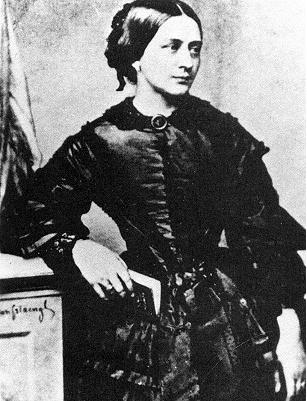Johannes Brahms
[1833~1897]
모두 24곡의 실내악곡을 남긴 브람스는 현악 6중주곡은 두 곡을 남겼다. 두 곡 모두 바이올린 2, 비올라 2, 첼로 2의 편성이다. 브람스의 젊은 날의 자화상과도 같은 이 두 곡은 평생을 통해 그에게 영향을 준
두 여인 클라라 슈만과 아가테 폰 지볼트와 깊은 관계가 있다. 브람스는 정신적으로 가장 기복이 심했던
1860년(27세)에 그의 현악으로는 첫 번째 실내악곡인 현악 6중주 1번 B플랫장조를 썼다. 그리고 그의
가슴에 늘 통증으로 남아 있던 지난날 사랑에의 회한을 나타낸 현악 6중주 2번 G장조는 1865년(32세)에 썼다. 브람스가 첫 현악 실내악곡으로 4중주보다 6중주를 선택한 것은, 그가 가장 존경하는 베토벤의 위대한 현악 4중주곡들을 모방한다는 두려움과 비교된다는 불편함이 있었을 것이기 때문이다.
그렇더라도 현악 6중주 1번의 풍부한 울림은 윤택한 직물을 짜는 듯한 브람스 특유의 대위법 운용에 더 맞는 것도 사실이다.
String Sextet No.1 in B flat major
Osostowicz,Øllgaard,Dann,Camille,Ylonen,Ortner,SMKS Denmark DR
The String Sextet No. 1 in B-flat major, Op. 18, was composed in 1860 by Johannes Brahms.
It was published in 1862 by the firm of Fritz Simrock.
The sextet is scored for two violins, two violas, and two cellos.
The sextet has four movements:[1]
- I. Allegro ma non troppo, in 3/4 time
- II. Andante, ma moderato, in D minor and 2/4 time (and in variation form)
- III. Scherzo: Allegro molto (3/4, in F major, with a central, Animato trio section)
- IV. Rondo: Poco Allegretto e grazioso, in 2/4
The outlines of the main themes of the first movement and finale are similar (the first four notes of the cello theme of the first movement are almost identical with those of notes two to five of the finale, and there are other similarities more easily heard).
'브람스의 눈물'이란 부제로 유명한 2악장.

< 클라라 슈만의 아름다운 모습 >
2악장: 안단테 마 모데라토 (브람스의 눈물)
‘브람스의 눈물’이란 부제가 훗날 붙여진 이 유명한 악장은 다소 어둡고 비가적인 느낌을 주는 D단조 주제와 6개의 변주곡 형식으로 구성되어 있다. 주제는 비올라, 바이올린 순으로 반복 연주된다. 제1변주는 주제 선율을 16분음표의 형태로 분해한다. 제2변주는 16분음표의 셋잇단 음형으로 구성되었다. 제3변주는 음계풍으로 진행하는 32분음표가 있다. 제4변주는 D장조로 바뀐 뒤 제1바이올린이 연주한다. 제5변주는 바이올린과 비올라 음형이 섞인다. 제6변주는 D단조로 되돌아가며 주제 선율이 재현된다.
Sextet chronology
There are earlier examples by Luigi Boccherini (two sets of six each). However, between the Boccherini and the Brahms, very few for stringed instruments without piano seem to have been written or published, whereas within the decades following Brahms' two examples, a number of composers, including Antonín Dvořák, Peter Ilyich Tchaikovsky, Joachim Raff, Max Reger, Arnold Schoenberg, and Erich Wolfgang Korngold, all wrote string sextets.
Those few examples of such sextets that appeared between the Boccherini and the Brahms include a sextuor a deux violins, deux violes, violoncelle & basse from the 1780s (still later than the 1776 or so of Boccherini's opus 23) by Ignaz Pleyel,[2] Ignacy Feliks Dobrzyński's opus 39 in E♭ (with double-bass, and published in 1848),[3][4][5] Louis Spohr's in C opus 140 of 1848, and the sextet in D minor (with double bass) by Aloys Schmitt of 1852 (one other possible exception is the sextet of Ferdinand David - published in 1861 and possibly performed in 1860.[6])
Popular culture
This sextet was used as soundtrack by French director Louis Malle in the movie "The Lovers" ("Les Amants", 1958).
The sextet's second movement is featured in the Star Trek: The Next Generation episode "Sarek". The second movement is also featured in "The Day of the Dead", an episode of Inspector Morse.
******************************************************************************************
String Sextet No. 2 in G major, Op. 36 - 일명 '아가테 6중주'
1864년 여름, 독일 서남부 산림지대 리흐텐탈에서 휴가를 즐기고 있던 브람스는 아가테가 교수가 되기 위해 아일랜드로 떠났다는 소식을 전해 듣는다. 아가테의 소식에 그동안 잠재해 있던 회한이 다시 소용돌이쳐 괴로워하던 브람스는 자신의 솔직한 감정을 음악에 담기로 하고 현악 6중주 2번의 작곡에 들어갔다.
브람스의 전기를 쓴 카를 가이링거에 의하면 이 곡 1악장에서 ‘Agathe’란 이름이 3번 암시되어 있다고 한다. 브람스의 암시는 이렇다. Agathe의 발음을 음으로 표시하면 ‘라-솔-라-시-미’가 되고 이를 알파벳으로 표시하면 ‘A-G-A-[T]H-E’(T는 생략, H는 ‘시’ 음)가 된다. 이에 대한 응답으로 브람스는 A-D-E(라-레-미)라고 했는데, A-D-E는 독일어로 ‘안녕’을 뜻한다고 한다. 그러니까 음으로 표시된 이 대목은 “아가테여, 안녕”이라는 뜻이 되겠는데, 이 ‘아가테의 주제’를 넣음으로써 브람스는 그녀에게 몹쓸 짓을 했다는 마음의 짐에서 벗어났던 것 같다. 그런 브람스의 마음을 헤아려서인지 사람들은 이 현악 6중주 2번을 ‘아가테 6중주’라고 부르기도 한다.
Johannes Brahms' String Sextet No. 2 in G major, Opus 36 was composed during the years of 1864–1865 and published by the firm of Fritz Simrock. It was first performed in Boston, Massachusetts on October 11, 1866.[1] The work is scored for two violins, two violas, and two celli, and has four movements:
- Allegro non troppo
- Scherzo – Allegro non troppo – Presto giocoso
- Adagio
- Poco allegro
Brahms did most of the composition in the comfortable country surroundings of Lichtental, near Baden-Baden. According to Brahms' biographer Karl Geiringer, it conceals a reference to the first name of Agathe von Siebold (with whom he was infatuated at the time) in the first movement, bars 162–168, with the notes a-g-a-h-e.[2]
The work is characterised by its exotic sounding opening of the first movement, by innovative chord structures and its many contrasts both technical and melodical.
Swedish composer Kurt Atterberg arranged the sextet for String orchestra in 1939.[3]
Popular culture
The first movement of this sextet is prominent in the last sequence of Bertrand Blier's 1979 film
<우리말 해설 자료 - 클래식 사랑방 자료에서 발췌 >'♣ 음악 감상실 ♣ > [ Brahms]' 카테고리의 다른 글
| Brahms-Double Concerto for Violin, Violoncello and Orchestra in a minor Op. 102 (0) | 2017.11.01 |
|---|---|
| Johannes Brahms - Variations on a Theme of Haydn for orchestra Op. 56a, 56b (0) | 2016.04.17 |
| Johannes Brahms - 현악 5중주 [String Quintet] 전곡 - 1, 2번 (0) | 2016.04.11 |
| Johannes Brahms -현악4중주 전곡[1,2,3 번] (0) | 2016.04.11 |
| Johannes Brahms - 피아노 4중주 전곡(1,2,3번) (0) | 2016.04.10 |
